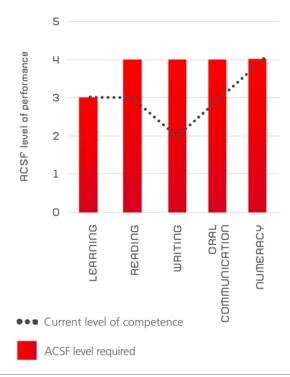Spiky profiles

It's normal for an individual to have different levels of ability for the five core skills. The ACSF is able to show these differences graphically through the use of 'spiky profiles'.
This allows a person's strengths and weaknesses to be identified, which helps to determine the areas that would benefit from remedial training.
It also enables their spiky profile to be compared to the profile for a unit of competency, or a whole qualification, or even a particular job role.
The spiky profile at right is taken from the ACSF document. It shows a sample comparison between an individual's actual ACSF levels (dotted line) and the levels required for a designated job or competency that they are planning to undertake (red bars).
You can see in this example that the person's learning and numeracy skills are adequate for the work they'll be doing, but they are likely to need some extra help in the other core skills. In particular, they may need additional training or specialist support in writing.

Go back to the full ACSF document.
This time think of a typical learner that you train. You might want to pick an individual you know well, or just think about the 'average' student in a particular group.
Compile a spiky profile for the learner.
Now choose one of the more challenging competencies that you deliver to this learner (or group).
- Which core skills have the greatest mismatch between what is expected of the learner to be assessed as 'competent', and what they are capable of when they begin the training?
- How do you currently address these mismatches? That is, what strategies do you use to help the learner improve their core skills in areas that need the most work?

